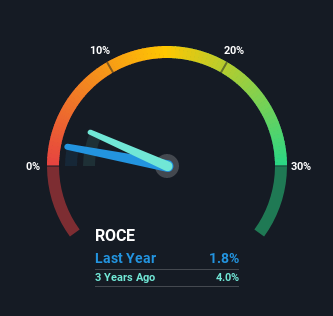- India
- /
- Construction
- /
- NSEI:AJRINFRA
Gammon Infrastructure Projects (NSE:GAMMNINFRA) Could Be At Risk Of Shrinking As A Company
When we're researching a company, it's sometimes hard to find the warning signs, but there are some financial metrics that can help spot trouble early. When we see a declining return on capital employed (ROCE) in conjunction with a declining base of capital employed, that's often how a mature business shows signs of aging. This reveals that the company isn't compounding shareholder wealth because returns are falling and its net asset base is shrinking. So after we looked into Gammon Infrastructure Projects (NSE:GAMMNINFRA), the trends above didn't look too great.
Return On Capital Employed (ROCE): What is it?
For those that aren't sure what ROCE is, it measures the amount of pre-tax profits a company can generate from the capital employed in its business. The formula for this calculation on Gammon Infrastructure Projects is:
Return on Capital Employed = Earnings Before Interest and Tax (EBIT) ÷ (Total Assets - Current Liabilities)
0.018 = ₹206m ÷ (₹38b - ₹27b) (Based on the trailing twelve months to December 2020).
So, Gammon Infrastructure Projects has an ROCE of 1.8%. Ultimately, that's a low return and it under-performs the Construction industry average of 9.2%.
View our latest analysis for Gammon Infrastructure Projects

Historical performance is a great place to start when researching a stock so above you can see the gauge for Gammon Infrastructure Projects' ROCE against it's prior returns. If you're interested in investigating Gammon Infrastructure Projects' past further, check out this free graph of past earnings, revenue and cash flow.
So How Is Gammon Infrastructure Projects' ROCE Trending?
The trend of ROCE at Gammon Infrastructure Projects is showing some signs of weakness. The company used to generate 2.4% on its capital five years ago but it has since fallen noticeably. In addition to that, Gammon Infrastructure Projects is now employing 87% less capital than it was five years ago. The fact that both are shrinking is an indication that the business is going through some tough times. If these underlying trends continue, we wouldn't be too optimistic going forward.
On a side note, Gammon Infrastructure Projects' current liabilities have increased over the last five years to 70% of total assets, effectively distorting the ROCE to some degree. Without this increase, it's likely that ROCE would be even lower than 1.8%. What this means is that in reality, a rather large portion of the business is being funded by the likes of the company's suppliers or short-term creditors, which can bring some risks of its own.
The Bottom Line On Gammon Infrastructure Projects' ROCE
In short, lower returns and decreasing amounts capital employed in the business doesn't fill us with confidence. Long term shareholders who've owned the stock over the last five years have experienced a 54% depreciation in their investment, so it appears the market might not like these trends either. With underlying trends that aren't great in these areas, we'd consider looking elsewhere.
If you want to know some of the risks facing Gammon Infrastructure Projects we've found 4 warning signs (1 doesn't sit too well with us!) that you should be aware of before investing here.
While Gammon Infrastructure Projects may not currently earn the highest returns, we've compiled a list of companies that currently earn more than 25% return on equity. Check out this free list here.
If you’re looking to trade Gammon Infrastructure Projects, open an account with the lowest-cost* platform trusted by professionals, Interactive Brokers. Their clients from over 200 countries and territories trade stocks, options, futures, forex, bonds and funds worldwide from a single integrated account. Promoted
New: Manage All Your Stock Portfolios in One Place
We've created the ultimate portfolio companion for stock investors, and it's free.
• Connect an unlimited number of Portfolios and see your total in one currency
• Be alerted to new Warning Signs or Risks via email or mobile
• Track the Fair Value of your stocks
This article by Simply Wall St is general in nature. It does not constitute a recommendation to buy or sell any stock, and does not take account of your objectives, or your financial situation. We aim to bring you long-term focused analysis driven by fundamental data. Note that our analysis may not factor in the latest price-sensitive company announcements or qualitative material. Simply Wall St has no position in any stocks mentioned.
*Interactive Brokers Rated Lowest Cost Broker by StockBrokers.com Annual Online Review 2020
Have feedback on this article? Concerned about the content? Get in touch with us directly. Alternatively, email editorial-team (at) simplywallst.com.
About NSEI:AJRINFRA
AJR Infra and Tolling
AJR Infra and Tolling Limited operates as an infrastructure project development company in India.
Good value with imperfect balance sheet.
Similar Companies
Market Insights
Weekly Picks


Crazy Undervalued 42 Baggers Silver Play (Active & Running Mine)


Fiducian: Compliance Clouds or Value Opportunity?

Willamette Valley Vineyards (WVVI): Not-So-Great Value
Recently Updated Narratives

THE KINGDOM OF BROWN GOODS: WHY MGPI IS BEING CRUSHED BY INVENTORY & PRIMED FOR RESURRECTION


The "Molecular Pencil": Why Beam's Technology is Built to Win


ADNOC Gas future shines with a 21.4% revenue surge
Popular Narratives


MicroVision will explode future revenue by 380.37% with a vision towards success


NVDA: Expanding AI Demand Will Drive Major Data Center Investments Through 2026




